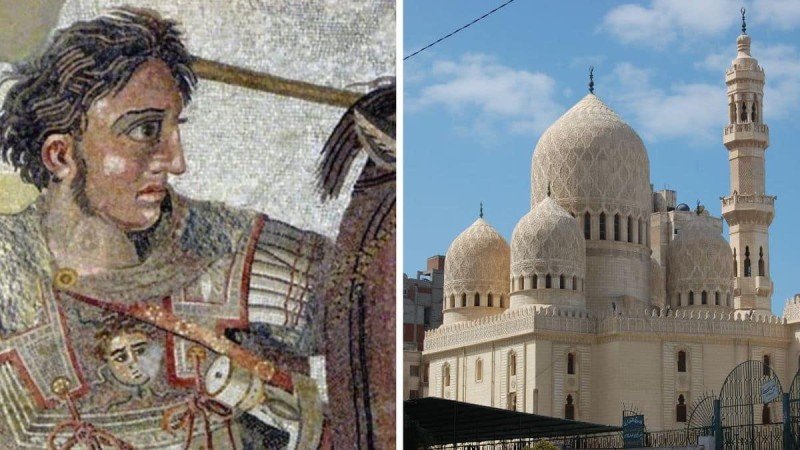It is the subject that stimulates the imagination, cultivates expectations and, of course, has managed not only to refute but also to ridicule quite a few archaeologists. According to Arabic tradition, the tomb of Alexander the Great is located in the Nebi Daniel Mosque. Scientists who let their imaginations run wild, fell prey to arbitrary assumptions, and completely ignored historical sources, searching in the most unlikely of places for the tomb of Alexander the Great have been misled in the worst of ways. And the great discovery of the Amphipolis monument leads to the revival of every possible version regarding where Alexander was eventually buried.
Certainly the tomb of Alexander the Great remains the... Holy Grail of archaeology. Most (and most serious) theories about the general's burial site come from Alexandria, Egypt, the city he founded. Alexandria is mentioned in historical sources while the magnificent mausoleum of Alexander in Alexandria was known.
The Christian attack on Alexandria
One of the black pages in the city's history, however, was written in the late 4th century AD and possibly connected to Alexander. It is the great attack of the Christians under Patriarch Theophilus against the pagans, in which the Library of Alexandria, the Serapeion and the Museum were destroyed, while the famous "Mausoleum" was lost in the ruins.
Alexandria, Kom el-Dikka Region
Recent hypotheses include that of a sarcophagus in a crypt of an ancient Christian church in Alexandria, Egypt, attributed by Polish archaeologists and historians to Alexander. A masterpiece of architecture, the marble and gold mausoleum was found in the Kom el-Dikka area, in the crypt of an early Christian church in the heart of Alexandria, just 60 meters from the Nabi Daniel Mosque, where, according to Arabic tradition, the Nabi Daniel Mosque is the tomb of Alexander the Great and where excavations are already underway.
The tomb has been a place of pilgrimage for centuries. Famous visitors included Roman emperors such as Julius Caesar and Gaius Octavius, better known as Augustus, who is said to have placed flowers on the tomb, as well as a gold diadem on the mummified head of Alexander the Great. The last recorded visit to the tomb was by the Roman Emperor Caracalla - who had been an admirer of Alexander about a year before his assassination in 215 AD. The crystal sarcophagus discovered in the mausoleum contains 37 bones attributed to men. The team of Polish archaeologists and historians that made the discovery are examining the 37 bones - using the radiocarbon method and other tests - in the hope that they will be identified as Alexander.
Not only the crystal sarcophagus is affected. The sacking of the sarcophagus found during the riots that shook Alexandria under Aurelius around 270 BC also aimed at the bones, which are also broken. As for why the sarcophagus is made of crystal, a first explanation from the Polish team is that the original golden urn was stolen. And above all by the Ptolemaic king Parisaktos or Kokkis (107 - 68 BC). Broken vessels from the Ptolemaic and Roman periods have also been found at the site.
Tour guide Ambroise Schilizzi had claimed to have discovered Alexander's mummy in an underground chamber beneath the Mosque of Nabi Daniel. All this while looking through a tiny hole in the wooden door. The year is 1850. Fifteen years later, Heinrich Schliemann arrived in Alexandria to excavate the area around the mosque. He never received permission from the Egyptian authorities.
Alexandria Roman Cemetery
An alabaster tomb discovered in 1930 in the Alexandria Roman Cemetery has been attributed to Alexander by Italian archaeologist Achille Adriani. Investigations that followed in the years that followed yielded no results.
Lebanon, Hills of Sidon
Another "Alexander's tomb" had been discovered near the hills of Sidon in present-day Lebanon. This time... Indiana Jones was the painter and collector Osman Hamdi Bey. The sarcophagus is said to have been moved as a prominent exhibit to the Ottoman Empire Museum in Constantinople, where for a time it was an irresistible attraction for visitors.
Venice, San Marco
Yes, there was also this scenario, according to which the body of Alexander the Great was accidentally transported by two Venetian merchants who were convinced that it was the body of Saint Mark.
Egypt, Oasis of Shiva
Archaeologist Liana Soulvatzi had caused a "stir" in the mid-1990s when she "revealed" that Alexander the Great was buried in the Oasis of Shiva but the tomb was eventually four centuries older than Alexander's death. The story began in 1992 with the first monument he found, which she called the "Tomb of Alexander the Great" and continued in 1995 with the second monument, which she also found and, based on inscriptions, also called the "Tomb of Alexander the Great" negating the first.
In the sarcophagus of the pharaoh Nectanebo II
Another hypothesis is that the tomb was destroyed during the persecutions of Christians in Alexandria at the beginning of the 5th century, but also that the body of the great general was placed in the - empty - sarcophagus of Pharaoh Nectanebo II.
Uzbekistan, Eskandar
However, Uzbekistan also once proclaimed that it possessed the tomb of Alexander the Great, claiming that it was located under a canopy in the village of Iskender Zulkernai. The inhabitants of the village of Eskandar in Uzbekistan claimed that Alexander the Great was buried there (so did a reporter from Skopje who was there to report on the "discovery", which was presented in a Sun TV broadcast).
Amphipolis
Many would like the discovered funerary monument to be the general's tomb - although the Macedonian royal capital is Aiges and Amphipolis is not mentioned (or even hinted at) in the sources as a possible burial place of Alexander the Great.









